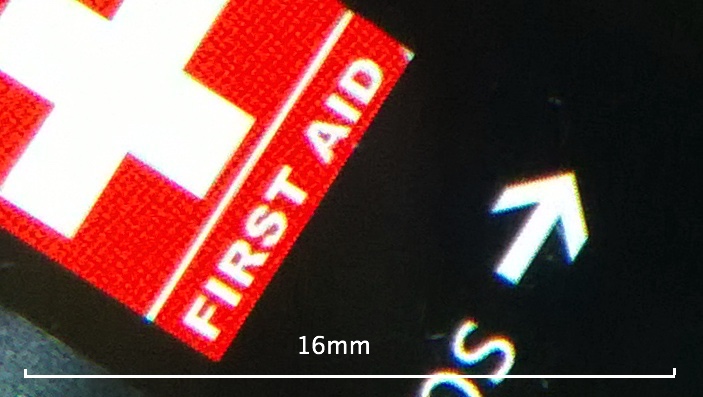
When talking 'up' the 720p screens on the likes of the Lumia 640 XL and 830, I correctly pointed out that they used full RGB pixel layouts, i.e. three sub-pixels for each one of those '720p' resolution pixels. Whereas you could argue that the 'pentile' pixel layouts on the likes of the 768p Lumia 1020/925 and the 1080p Lumia 930 were in fact lower resolution, since you've only really got 384 or 540 sub-pixels of red or blue in the usually quoted smaller screen dimension. You could argue that, as I did, but it's (as I say) rather misleading.
But let's back up a little - 'pentile' screens, i.e. deliberately cutting down on the number of sub-pixels, are a phenomenon of the AMOLED age. We've all seen the glorious colours of new AMOLED screens, with each pixel illuminating directly rather than relying on a backlight (as 'passive' LCD screens do), but AMOLED does have a few disadvantages. I went into some of these in my article 'Why LCD is now a better choice than AMOLED for smartphones' recently, but one of these is that longevity takes a hit because the blue sub-pixels (in particular) degrade in intensity with use. I examined the degree to which this is true here.
Add in that the human eye has different sensitivity to red/blue/green light and you can see that simply having a Red/Green/Blue 'stripe' of pixels isn't necessarily the best option for AMOLED displays. Instead, by halving the relative number of red and blue pixels, shown diagrammatically above and photographically below, the lifetime of the display can be extended, perhaps from a year to several years of good performance. (Contrast this to many years for LCD, of course.)
(close-up photo of a Lumia 930 panel from Anandtech, note the four pixel groupings result in half the raw resolution in each direction for red and blue)
In the absolute worst case, for displaying blocks of red or blue, you'd then be dealing with half the quoted resolution of the screen, i.e. 540p for the Lumia 930. However, rather obviously, when displaying blocks of colour there's nothing complicated or with fine detail to show, so this drop down makes no difference. For real world photos, icons, text and other layouts, with a mix of colours and textures, clever electronics behind the screen, allied to support from the Windows Phone OS, 'sub pixel rendering' is used (similar in concept to the anti-aliasing used on desktop and laptop screens), combining output from combinations of sub-pixels in the layout shown above in order to show finer detail than you might think.
At best, this can approach the full resolution of green sub-pixels (e.g. 1080p), at worst the aforementioned 540p - in reality, averaged across general content, the perceived resolution will be closer to the former, perhaps '800p' or '900p', depending on exactly what's being shown.
When 'pentile' displays are criticised, the criticism is therefore rarely about the resolution of displayed content - the 930's presentation of photos and other graphical content on its 1080p pentile display is indistinguishable to the naked eye from the same on a 1080p (RGB) LCD panel. Criticisms of pentile usually centre around 'fringing' on the edge of solid blocks of colour (and sometimes text, depending on the font being used). Here's a close-up of one of the icons from my People tiles on the Lumia 930, showing a block of red colour and nice blocks of white colour:

Now, allowing some artefacts and fringing from the fact that I was photographing a pentile display with a RGB sensor followed by you viewing this on a monitor of some kind (which itself might be pentile - it's getting complicated, eh?!), what you can see if you look closely are slight orange and purple fringes on the edges of blocks of red. Plus, in the white arrow head, the same fringes on the edge of each part of the shape. What you're seeing are artefacts of the way sudden, abrupt colour changes from pixel to pixel are impossible to represent accurately using sub-pixel rendering, obviously.
However, note the scale (I added that to the image). The fringes, here on the 1080p Lumia 930, are of the order of 0.06mm in size, i.e. 60 microns. I'm sure there are people living with 20:20 vision who can discern detail this small at, say, 30cm distance, but everyone else on the planet wouldn't notice such minor aberrations. At worst case there might be a very, very slight awareness (at 1080p) that something's 'not quite crisp enough' when displaying text.
If I'm sounding like a pentile apologist then you'd be right. I set out to work out the scale of the issue and I concluded that it's not worth worrying about on modern high resolution AMOLED screens. Now, cast your mind back to devices like the Nokia Lumia 800 and Nokia N9, both essentially 4" (or just below) 480p pentile screens. For these, pentile fringes were double the physical size (up to 0.2mm) and very definitely visible to anyone with good eysight - hence pentile's somewhat damaged reputation.
But the Lumia 930 - and Samsung's Galaxy S4/S5/S6/Note 3/Note 4 (etc.), incidentally - all happily use pentile AMOLED at such high resolutions that fringing simply isn't a problem.
So now you know!
